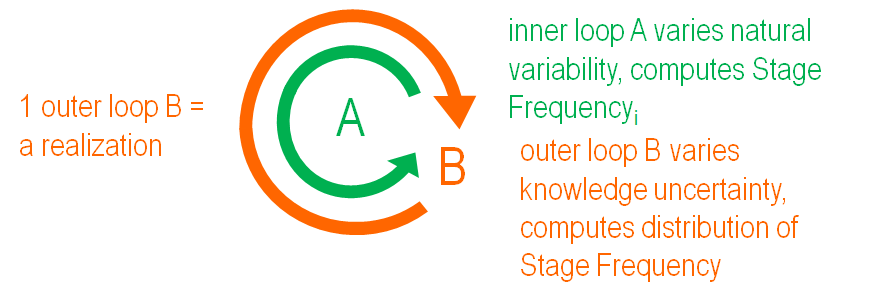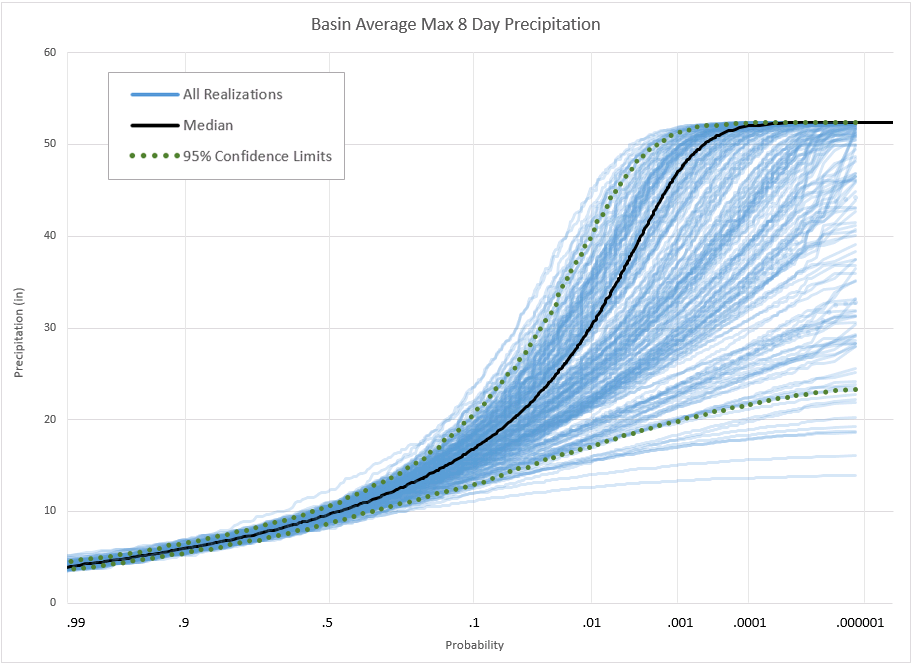Flood Risk Analysis
The HEC-WAT framework includes a Flood Risk Analysis (FRA) compute option which performs a nested Monte Carlo simulation to evaluate the impact of natural variability and knowledge uncertainty on decision metrics. A nested Monte Carlo simulation consists of two loops, an inner loop and an outer loop. The Monte Carlo samples from the inner loop have two characteristics:
- they span the probability range
- they express an estimate of a frequency relationship that describes natural variability
The outer loop samples knowledge uncertainty which would produce a different estimate of the frequency relationship (a realization of reality based on our limited knowledge of truth). The result of the combined loop is a best estimate of the frequency relationship and an explicit accounting of the uncertainty in that relationship. This computational strategy provides the tools necessary to include risk and uncertainty in water resources modeling efforts pursuant to USACE guidelines and regulations.

Knowledge Uncertainty
Knowledge Uncertainty describes things we do not know with certainty, but that can be known. For instance, what is the height of the foundation of a given structure in the structure inventory?
Natural Variability
Natural Variability describes things that we can not know with certainty, because they vary naturally. For instance, what is the flow in the river going to be on April 3rd next year?
Flood Risk Analysis – Knowledge Uncertainty and Natural Variability
In the FRA compute option, the outer loop will sample a set of parameters for defined knowledge uncertainties. The inner loop will use those parameters and sample natural variability values along the full range of probability. The plot below was developed using the Hydrologic Sampler to produce precipitation hyetographs for a watershed. The range of values expressed by the black line best represents the natural variability of the system - e.g. the range of possible annual maximum 8-day precipitation for the basin naturally varies between 5 inches of precipitation to around 52 inches of precipitation. The individual blue traces each represent an estimate of the natural variability which expresses our knowledge uncertainty of the relationship of precipitation frequency based on our limited knowledge of the population of potential annual maximum 8 day precipitation values. Our observed data that drives our input into our models reflects our best estimate of the population parameters, but our limited information can be used to infer the uncertainty we have in that best estimate. In the image below each blue trace is derived from the input summarization of observed data using an analytical bootstrap (in this case) of the underlying analytical distribution used to summarize the observed data.
The group of blue lines represent the impact of knowledge uncertainty on our ability to estimate the precipitation for a given probability of occurrence, or to estimate the probability of occurrence for a given precipitation. For instance, in the graphic below if a vertical line is drawn at the 0.01 probability on the x axis (e.g. the 100 year recurrence interval) there is a range of possible 8-day maximum precipitation values from about 15 inches to almost 45 inches because there is uncertainty in the 0.01 percent chance precipitation. This modeling structure and resulting output provides the ability to provide a range for any recurrence interval rather than a deterministic estimate. The collection of blue traces can also be used to express the range of possible exceedance probabilities that could be assigned to any 8-day maximum precipitation. This can be visualized by a horizontal line at any precipitation value; for instance, if we draw a horizontal line at the 10 inch line, our best estimate of the exceedance value for that precipitation would be slightly more frequent than the 0.5 probability, but the value would range between slightly less than 0.5 to nearly 0.1 probability.

Note
Not all the models are required to run an FRA compute. For example, an FRA compute can be configured with the Hydrologic Sampler and HEC-HMS only in the compute sequence. This shortened compute sequence could be used to simply evaluate how uncertainty around meteorologic information might impact flow frequency at locations within a watershed.